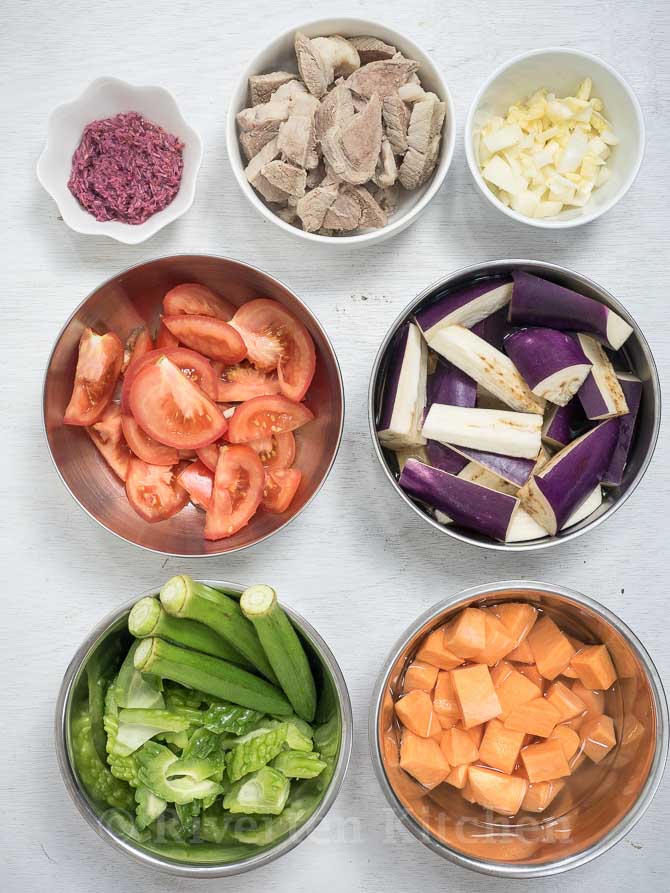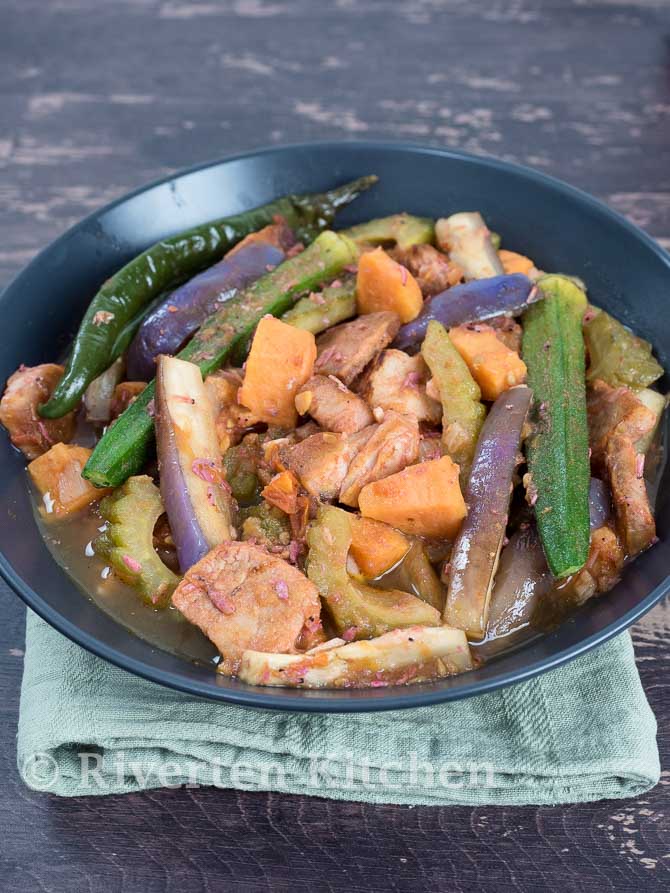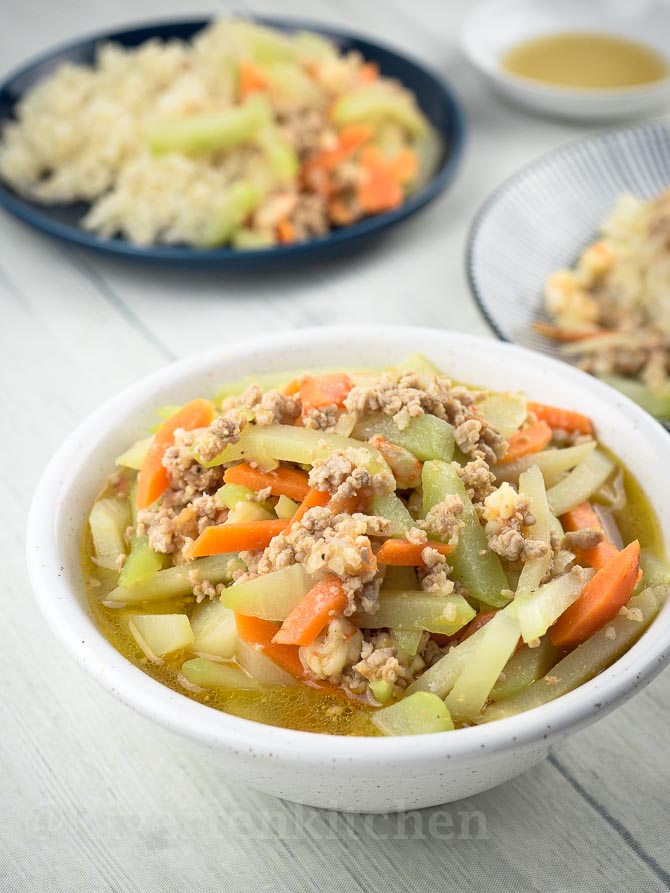Pinakbet is a Filipino vegetable dish made of eggplant, okra, ampalaya, and pork (baboy) stewed in tomatoes, and bagoong. It can be salty, rich, bitter, and naturally sweet with the addition of camote (sweet potato) and other root crops.

I loved Pinakbet even as a kid. You probably don’t hear that often especially since it’s a vegetable dish. But, it’s probably true for most people especially if you grew up in Pangasinan—the land of all things bagoong.
Bagoong-alamang or Bagoong-Isda
Bagoong is the main flavoring in Pinakbet. It’s made of fermented fish or shrimp. It may be funky and salty but those characteristics are what make Filipino dishes distinctly delicious from all other cuisines.
Pinakbet comes in two main variations: Pinakbet sa bagoong-isda (fermented fish) or Pinakbet sa bagoong-alamang (fermented shrimp). Both produce different flavor profiles when used for Pinakbet but the method on when to incorporate them into the dish is generally the same.
Using good quality bagoong is the best tip I can give for anyone who loves to use it as a flavoring. I know this is especially tricky if you’re living outside of the Philippines but when you find your favorite brand stick to it. Remember, not all bagoong are made the same.

Pinakbet Vegetables
The three main ingredients of pinakbet are ampalaya, talong and okra. Other vegetables are often used for variation, depending on what’s available or in season.
To balance the saltiness of the bagoong, I personally love adding root crops such as kamote (sweet potato) and gabi (yam). They also make the sauce a little bit thick and starchy which makes Pinakbet even more delicious!
Here is the list of vegetables you can use interchangeably for Pinakbet.
- Ampalaya (bitter gourd)**
- Talong (eggplant)
- Tomatoes
- kalabasa (squash)
- Sigarilyas (Winged Bean)
- Sitaw (long green beans)
- Kamote (Sweet Potato)
- Bulaklak ng Kalabasa (Squash flower)
- Gabi (Yam)
- Malunggay bunga (Moringa Sticks)
- Green Sili (long green chili)
From the list, I think ampalaya is the most important as it is what gives Pinakbet the distinct bittery taste and aroma.
**To prepare ampalaya or bitter gourd, trim both ends. Cut in half lengthwise then scrape off the seeds with a small spoon. Cut into 1/4 inches or thicker if preferred. If you are not a fan of the bitterness, there are a couple of ways to lessen it.

How to make a delicious Pinakbet with Pork
Start by boiling the pork. Pork ribs and pork belly are my favorite cut for Pinakbet. Once it becomes tender, remove it from the liquid (reserve the broth for later use) then fry in hot oil until brown and the fat has rendered. This will give the sauce so much flavor.
Next, saute the aromatics such as garlic and onion until fragrant. This method is also known as gisa or ginisa in Filipino.
Add the tomatoes. Use lots of it. Let it soften until its reddish juices come out. At this point, you can add your choice of root crops and your choice of bagoong. But don’t add the water or broth yet. Continue simmering over low heat until it becomes fragrant. You’ll know when it’s ready, trust me 🙂 Note that this step is crucial when making Pinakbet so don’t skip it.
Pour the broth then let it boil before finally adding your choice of vegetables. Toss it gently with the sauce. Use two spatulas to avoid mushing the vegetables. Pour the pork broth and cover with a lid until they’re almost done. Remove the lid immediately and let the residual heat finish cooking.
Some like their pinakbet mushy while some like it to be crunchy. So adjust your cooking time based on your preference. I personally like it to be cooked just right except for the amplaya. I intentionally overcook it to lessen the bitterness so I often add it together with the root crops (see video).
That is it!
Serve with rice and enjoy!
Watch the video on how to make Pork Pinakbet
More Filipino recipes
HUNGRY FOR MORE? Subscribe to my newsletter and follow along on Facebook, Pinterest, and Instagram for all of the latest updates.

Pork Pinakbet
Ingredients
- 300 grams pork (boiled until tender)
- cooking oil
- 1 small onion (sliced)
- 3 cloves garlic (sliced)
- 2 tomatoes (quartered)
- 1 small sweet potato (diced)
- 2 small bitter gourd (ampalaya) (scoop seeds then slice into pieces)
- 1 tablespoon fish sauce (patis)
- 2 tablespoons bagoong (I used alamang, add more if preferred.)
- 3 cups pork broth
- 2 eggplant (talong) (sliced)
- 4 pieces okra (ends trimmed)
Instructions
- Heat oil in a pot over medium heat. Fry boiled pork until brown. Add onions and garlic stir-fry until fragrant and translucent. Add chopped tomatoes. Cover with lid and let it cook until soft, about 5 minutes.
- Add sweet potatoes and fish sauce. Let it simmer with the juices for about 5 minutes. Add bitter gourd (ampalaya) and bagoong. Continue cooking over low heat until fragrant, about 2 to 3 minutes.
- Add green chili and pork broth. Cover with lid and let it boil until the sweet potato is half-cooked about 10 minutes.
- Stir in the okra and eggplant or your other choice of vegetables. Cover with lid and continue cooking for another 5 minutes in medium to high heat. Once the okra and eggplant have slightly softened, remove the lid and let the residual heat finish the cooking. Serve with rice and enjoy!
Recipe Notes & Tips:
- Use two spatulas to avoid mushing the vegetables.
- Some like their pinakbet mushy while some like it to be crunchy. So adjust your cooking time based on your preference. I personally like it to be cooked just right except for the amplaya. I intentionally overcook it to lessen the bitterness so I often add it together with the root crops (see video).
- To prepare ampalaya or bitter gourd, trim both ends. Cut in half lengthwise then scrape off the seeds with a small spoon. Cut into 1/4 inches or thicker if preferred. If you are not a fan of the bitterness, there are a couple of ways to lessen it.






